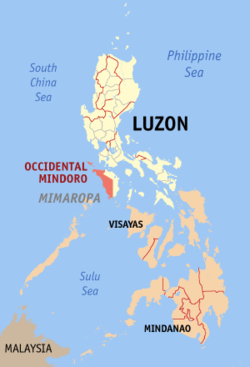Occidental Mindoro
| Occidental Mindoro | |||
|---|---|---|---|
| Province | |||
| Province of Occidental Mindoro | |||
|
|||
 Location in the Philippines |
|||
| Coordinates: 13°00′N 120°55′E / 13°N 120.92°ECoordinates: 13°00′N 120°55′E / 13°N 120.92°E | |||
| Country | Philippines | ||
| Region | Mimaropa (Region IV-B) | ||
| Founded | 1950 | ||
| Capital | Mamburao | ||
| Government | |||
| • Type | Sangguniang Panlalawigan | ||
| • Governor | Mario Gene Mendiola (LP) | ||
| • Vice Governor | Peter Alfaro(LP) | ||
| Area | |||
| • Total | 5,865.71 km2 (2,264.76 sq mi) | ||
| Area rank | 11th out of 81 | ||
| Population (2015 census) | |||
| • Total | 487,414 | ||
| • Rank | 56th out of 81 | ||
| • Density | 83/km2 (220/sq mi) | ||
| • Density rank | 71st out of 81 | ||
| Divisions | |||
| • Independent cities | 0 | ||
| • Component cities | 0 | ||
| • Municipalities |
11
|
||
| • Barangays | 162 | ||
| • Districts | Lone district of Occidental Mindoro | ||
| Time zone | PHT (UTC+8) | ||
| ZIP Code | 5100–5111 | ||
| IDD : area code | +63 (0)43 | ||
| ISO 3166 code | PH-MDC | ||
| Spoken languages | |||
| Website | www |
||
Occidental Mindoro (Tagalog: Kanlurang Mindoro, Spanish: Mindoro Occidental) is a province in the Philippines located in the Mimaropa region. Its capital is Mamburao and occupies the western half of the island of Mindoro.
The province is bordered on the east by the province of Oriental Mindoro, and on the south by the Mindoro Strait. The South China Sea is to the west of the province and Palawan is located to the southwest, across the Mindoro Strait. Batangas is to the north, separated by the Verde Island Passage.
Mindoro Island was originally known to the ancients as Ma-i. It was formally called Mait, and known to the Chinese traders before the coming of the Spanish. Its existence was mentioned in the old Chinese chronicles in 775 A.D. and more elaborately in 1225. It was a major anchorage in the Southeast Asia trade route during the pre-Philippines period. Chinese, Arab and Indian merchants traded with the natives. In 1570, the Spanish began to explore the island and named it Mina de Oro ("mine of gold") after finding some of the precious metal, though no major gold discoveries were ever made.
The natives of Mindoro were called Manguianes by the Spaniards. But the natives refer to themselves by their ethnic or clan identification. There were seven such ethnic or clan distinctions, which are differentiated by language and areas where each can be found.
The Mangyans, as they are now anthropologically known, do not have a warrior society. They are a peaceful, shy but friendly people. They are rarely known to be hostile, and have had no significant record of violent conflict with other people in the entire history of the province. They grow root crops in forest clearings (slash and burn farms), and hunt wild animals in the forest for their meat needs.
...
Wikipedia


